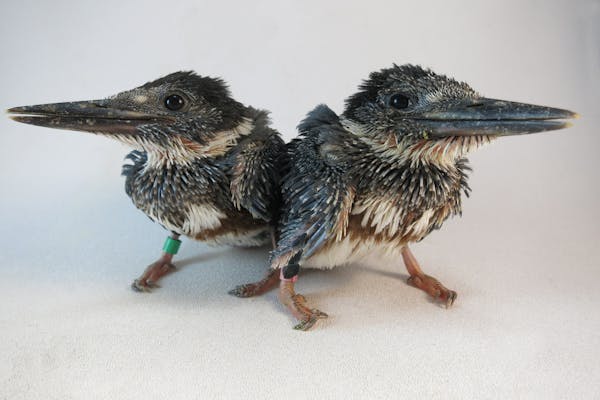A roving band of chickadees sweeps through the forest on a winter's day, noisily chattering as they busily search bark crevices and evergreen needles for hibernating insects and spiders.
A white-breasted nuthatch, the "upside down bird," pecks at suet in a feeder, then grabs a sunflower seed and flies to a perch to hack it open.
Just after sunrise a downy woodpecker pops out of her tree-hole night roost to warm up with bits of suet, then pecks chips of peanuts out of a feeder to start her day.
While we're all noticing many fewer birds in our backyards, now that migration has wrapped up and winter has settled in, there's still a lot going on in the bird world in wintertime. At this season, birds aren't distracted by the need to hold territories or raise a family. Instead, this is the season of laser-like focus on food, on consuming enough calories during the day to make it through the long cold nights.
Being able to fly confers wonderful advantages in the survival sweepstakes, but it has its costs, especially the need to remain light in weight. This means birds can't build up much of a fat layer for insulation; instead, they burn calorie reserves during the night, and most face the sunrise weighing a good deal less than at nightfall.
Winter birds are hardy birds, well prepared to withstand the cold and ready to labor all day long to stoke their inner furnaces. With body temperatures averaging around 104 degrees, it takes a big load of calories to offset the much lower outdoor temperatures. Chickadees, for example, eat more than 35% of their body weight each day in winter.
The calorie search is made harder by the fact that winter days are much shorter, nearly seven hours shorter in the depth of winter, than days at the peak of summer. The need for more calories to survive in winter combined with less time to acquire it mean that winter birds need skill, intelligence, experience and more than a little luck to survive until spring.
Some 15 species of birds may flit around the backyard landscape several times a day. Birds have winter feeding territories but they don't defend them with breeding season's vigor.
They're busy hunting for shriveled berries on vines and shrubs, insects hibernating in bark and in crevices, tree berries like those on hackberry, crabapple and mountain ash trees, and plant seeds. They also are attracted to seeds, nuts and suet at backyard feeders to give a quick energy boost for very little effort, important in a season when they must balance a tight energy budget. If they have to burn more calories in foraging for food than the food provides, they won't last long.
The longer they live the better birds become at surviving, but there's no safety net and little forgiveness for mistakes. There are still predators lurking in winter, chiefly bird-eating Cooper's hawks and free-roaming cats, each counting on a moment of inattention or a heedless flight into the open by their prey.
And there's always the relentless cold to contend with. Anything you can do, from maintaining well-stocked feeders to providing places to shelter from the cold, will help make each winter day just a bit easier for birds.
St. Paul resident Val Cunningham, who volunteers with the St. Paul Audubon Society and writes about nature for local, regional and national newspapers and magazines, can be reached at valwrites@comcast.net.
Birds to watch for
About three-fourths of our summer birds have departed for the winter, but you can still spot these winter standbys in your backyard or out for a walk.
Cardinals, chickadees, blue jays. downy woodpeckers, hairy woodpeckers, red-bellied woodpeckers, pileated woodpeckers, white-breasted nuthatches, juncos, goldfinches, house finches, house sparrows, starlings, crows.
Homemade 'suet'
Here's a recipe from Audubon for a homemade treat for winter birds, such as woodpeckers, chickadees, nuthatches, blue jays, finches, even house sparrows. Really, nearly all backyard birds will relish suet, including cardinals and wintering robins (although these latter birds' beaks can't penetrate suet cages).
• 3 1/2 cups wild bird seed
• 1 cup quick oats
• 1/2 cup cornmeal
• 1 1/2 cups shortening (look for palm oil free options)
• 3/4 cups nut butter (any kind)
• Ice cube tray
Mix the dry ingredients together and set aside. Combine the shortening and nut butter in a separate bowl and melt. Stir until completely combined. Pour the melted mixture into the dry ingredients and stir until combined. Spoon mixture into the ice cube tray. Freeze for one to two hours and place cubes in your suet feeder. Note: Not recommended for outdoor temperatures above 50 degrees.
High energy seeds
Winter birds flock to seed-filled feeders, especially those holding high-fat black-oiler sunflower seeds. Safflower is good, too, and finches are fans of nyger seed. Shelled sunflower seeds are easy for most birds to eat and offer the advantage of no dropped shells. Birds that feed on the ground — juncos, cardinals, sparrows — search eagerly for millet seed and cracked corn.
Give 'em shelter
Brush piles offer life-saving shelter for winter birds. Audubon offers some good building tips: audubon.org/news/build-brush-pile-birds. And don't forget your holiday evergreen: If placed in the backyard it can have a second life as a bird shelter.

The 5 best things our food writers ate this week

A Minnesota field guide to snow shovels: Which one's best?

Summer Camp Guide: Find your best ones here

Lowertown St. Paul losing another restaurant as Dark Horse announces closing

